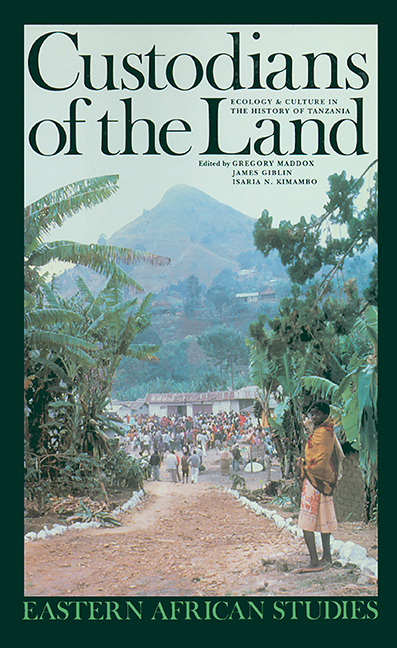Book contents
- Frontmatter
- Contents
- List of Maps, Figures & Tables
- List of Photographs
- Abbreviations
- Contributors
- Acknowledgements
- Introduction Custodians of the Land: Ecology & Culture in the History of Tanzania
- Part One Environmental & Demographic Change
- Part Two Environmental Change & Economic History: In Tanzania's Northern Highlands
- Part Three Politics & Environmental Change
- Part Four Environment & Morality
- Conclusion
- Bibliography
- Index
Part Three - Politics & Environmental Change
Published online by Cambridge University Press: 30 August 2017
- Frontmatter
- Contents
- List of Maps, Figures & Tables
- List of Photographs
- Abbreviations
- Contributors
- Acknowledgements
- Introduction Custodians of the Land: Ecology & Culture in the History of Tanzania
- Part One Environmental & Demographic Change
- Part Two Environmental Change & Economic History: In Tanzania's Northern Highlands
- Part Three Politics & Environmental Change
- Part Four Environment & Morality
- Conclusion
- Bibliography
- Index
Summary
This section includes two chapters on culturally similar areas of eastern Tanzania. James Giblin discusses Handeni District in the nineteenth and early twentieth centuries and Pamela Maack studies the Uluguru Mountains of Morogoro during the 1940s and 1950s. Both contributions find close connections between environmental change and political life. In the late precolonial farming communities of rain-poor Handeni, argues Giblin, political relationships with patrons provided many agriculturalists with access to sources of food during periods of shortage. Because stable communities did not disperse in search of food with the onset of each episode of dearth, they were able to control vegetation and wildlife and thus maintain cattle diseases in an endemic state. The breakdown of this form of environmental control can also be attributed to political conditions, for, when the power of Handeni's patrons was broken by colonial conquest, farmers lost their security against food shortage, famines provoked the flight of the destitute, and bush, wildlife and disease-bearing insects encroached upon the remaining villagers and their cattle. In Handeni, famines were both the cause and consequence of environmental deterioration, because the depopulation which followed famine hastened the worsening of the disease environment and the loss of cattle to disease made famine more likely. In at least two respects, conditions in Handeni seem to have resembled those found in other regions. For example, in both Handeni and the Dodoma instance discussed by Gregory Maddox, famine caused depopulation and led to environmental deterioration. Moreover, in several regions, the decline of patronage made villagers much more vulnerable to famine and destitution. However, there is a contrast between Handeni, where Giblin sees a steady decline in patronage after 1890, and Dodoma, where Maddox finds that the fortunes of Dodoma patrons waxed and waned depending upon wider conditions within the colonial economy. Nevertheless, it is clear that the British policies which prevented the reconstruction of patronage networks in Handeni during the interwar period had their counterparts in the Kilombero Valley where, as Monson shows, forest conservation and restrictions on trade created difficulties in maintaining cooperation among walongo, the mutual aid groups, which must certainly have included patrons and their clients.
- Type
- Chapter
- Information
- Custodians of the LandEcology and Culture in the History of Tanzania, pp. 123 - 126Publisher: Boydell & BrewerPrint publication year: 1996

